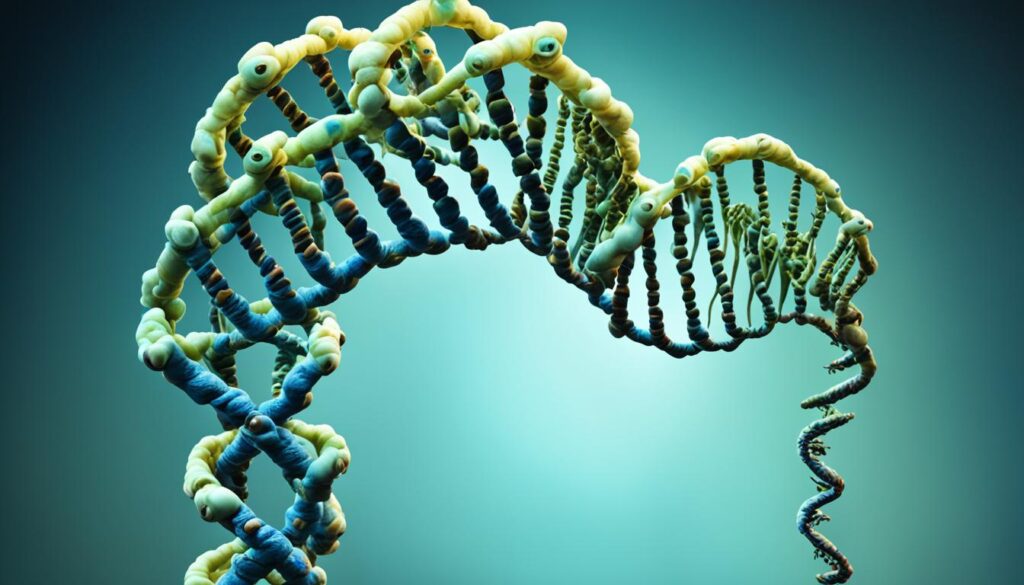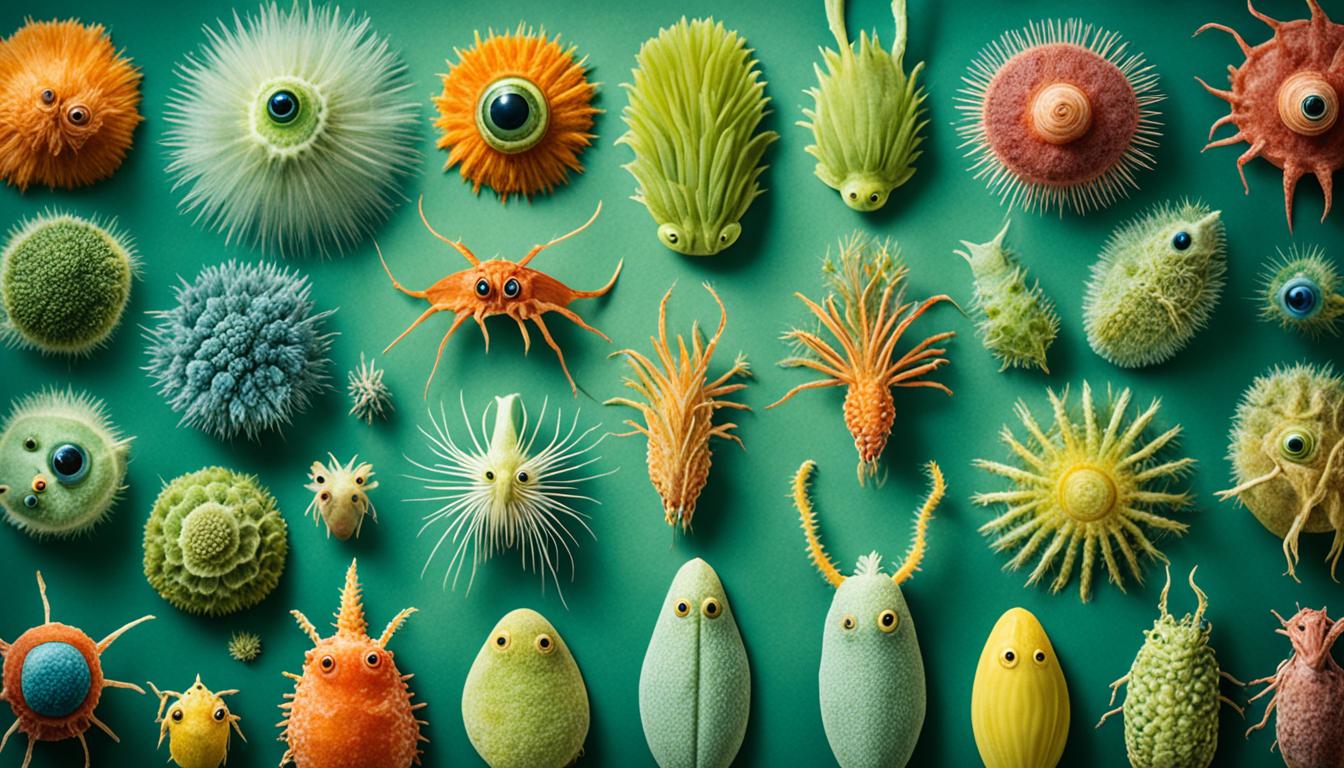In nature’s rich tapestry, we often find marvels that make us rethink biology. Thanks to advanced genetic studies, we’ve found amazing genetic anomalies. They highlight the vast diversity and resilience of life forms. Creatures with one eye or extra fingers show us the amazing adaptability and complexity of nature. This article will dive into 12 extraordinary genetic anomalies. These oddities have fascinated scientists and the public, showing the incredible influence of genetic variation.
Mesmerizing Genetic Marvels
The natural world is full of genetic diversity, shaped by evolutionary biology and natural selection. Within this diversity, some genetic anomalies stand out. They make us wonder and push the bounds of our biological knowledge.
Uncovering Nature’s Enigmatic Wonders
Some genetic marvels are born from rare changes or evolutionary adaptations. They show us the mysteries of nature. Creatures with one eye or people with extra fingers highlight the variety and strength of life.
Genetic Diversity: A Tapestry of Life
Studying these unique genetic cases helps us learn more and dig deeper into the workings of evolutionary biology. It also shows how rich and varied life can be.
Cyclopia: The Single-Eyed Marvel
One of nature’s most fascinating genetic quirks is cyclopia. It’s when a creature grows a single, centrally-placed eye. This condition is rare and results from a genetic mutation affecting the face and skull development. It’s been seen in various animals, including fish, amphibians, and mammals.
The craniofacial development of these organisms changes dramatically. They end up with one eye in the middle of their face. Sometimes, it comes with other facial and skull issues. This unusual trait has intrigued scientists and the public. It shows how diverse and complex nature is.
Scientists are working hard to understand the genetic mutations causing cyclopia. They aim to grasp the detailed processes affecting vertebrate head and face growth. By examining single-eyed animals, experts learn a lot. They discover key pathways and molecules in face and head development. This work deepens our knowledge of how genes shape our bodies.
Our exploration of cyclopia also highlights life’s amazing variety and resilience. These unique genetic conditions captivate us. They make us rethink what’s “normal”. And they push our scientific boundaries. It’s a reminder of the wonders and possibilities in our natural world.
Albinism: Nature’s Ethereal Beauty
Albinism is a captivating genetic condition we find in nature. It means the organism’s skin, hair, and eyes lack color. This happens because of a genetic mutation that affects how melanin is made or spread. As a result, individuals have a unique, very pale look.
Exploring the Genetic Roots of Pigmentation
Albinos have little or no melanin due to a genetic mutation. This mutation affects how their bodies make color. It can cause a range of effects, from complete lack of color to some leucism where there’s less color than normal.
Albino Animals: Unique and Captivating
Albino animals stand out and grab our attention. They’re seen as representatives of genetic diversity and genetic mutation in nature. Think about the ghostly white tigers from India or the delicate albino hummingbirds in the Americas. These animals are wonders. They reflect how life can adapt and survive, even in very different ways.
Genetic studies: Unveiling Nature’s Secrets
Scientists are very interested in the strange genetic things in nature. This interest has led to a lot of important new genetic studies. Through scientific research in evolutionary biology and genetic diversity, we are learning a lot. We now know more about nature’s amazing adaptations and strengths.
Cutting-Edge Research in Genetics
New technologies allow researchers to look more closely at genes. They find out how unique traits are passed down. By studying these unusual features, we get a glimpse of how life’s diversity has developed over time.
Ethical Considerations in Genetic Studies
But, there are important ethical considerations we must always think about. It’s key to use these tools with care, protecting privacy and diversity. This helps us move forward in science the right way, respecting all life forms.

Polydactyly: The Quirky Extra Digits
Polydactyly is a visually striking condition where someone has extra fingers or toes. This unique trait happens because of a genetic mutation. It affects limb development and can be found in many species.
Evolutionary Perspectives on Polydactyly
Polydactyly showcases how amazing living organisms can adapt. The extra digits come from genetic changes. They vary in size and shape. These changes can sometimes help the organism to use their hands or feet better.
Scientists are studying the genes behind polydactyly. They’re finding a complex mix of genes that affect limb growth. Looking at its history in different species shows us amazing genetic changes. It helps us understand the world’s genetic variety.
Conjoined Twins: A Rare Genetic Phenomenon
Two people fused at birth, known as conjoined twins, are a rare yet captivating discovery. It happens about once in every 200,000 births. This condition shines a light on how intricate embryonic development can be, interesting both scientists and the public.
When conjoined twins form, it’s due to a genetic error early in the mother’s pregnancy. This error prevents the twins from separating fully. The level of connection varies, from sharing organs to a heart or a single body cavity.
Research on conjoined twins aids in understanding how our bodies develop and the influence of genes. Experts in teratology, the study of abnormal birth, are keen on this condition. They work to uncover its causes and potential cures.

Although conjoined twins are extraordinarily rare, they remind us of life’s surprising diversity. These cases challenge the way we view biology. They show the human body’s incredible strength to survive in unique situations.
Progeria: The Aging Enigma
Progeria is a rare and hard condition marked by faster aging. People with progeria, or HGPS, typically live only until their early 20s. It’s a very unique genetic issue found in nature.
Understanding the Mechanisms of Premature Aging
A gene mutation in the lamin A gene causes progeria. This gene is vital for the cell nucleus’s health and structure. The mutation produces a harmful form of lamin A, called progerin. It speeds up aging in cells.
Understanding how progeria works has been a big goal for scientists. They’ve found out a lot about how genes, cells, and the body’s growth and aging connect. These studies also help understand aging better in everyone.
Supportive Care for Individuals with Progeria
Even though there’s no cure, experts work on ways to support those with progeria. They focus on easing the tough parts of aging too soon. This means watching out for heart problems, osteoporosis, and stroke, and giving special care.
Researchers are also looking into new treatments for progeria. These might include adjusting genes or new medicines. The goal is to slow down or even stop progeria’s effects. This could bring hope to those with this rare genetic issue.
Dwarfism: Small Stature, Big Impact
Dwarfism is a rare condition where people are much shorter than usual. It’s caused by different gene problems. This makes us think about how our genes work and how they shape our bodies. Scientists and everyone else find it interesting because it shows how diverse life can be.
Genetic Diversity in Dwarfism
Many different gene changes can cause dwarfism. These changes affect how the skeleton grows and the shape of bones. There are more types of dwarfism than you might think, from common ones like achondroplasia to very rare ones. This shows how varied and complex dwarfism is.
Looking at the genes behind dwarfism shows us amazing things about life. Some beings can still do well even when they look very different. This tells us about the power of genetic diversity in nature. It’s truly fascinating and makes us appreciate life even more.
By learning more about dwarfism, we see the wonders of the nature’s variety. Keep being curious and exploring, and we’ll find even more amazing things in the natural world.
